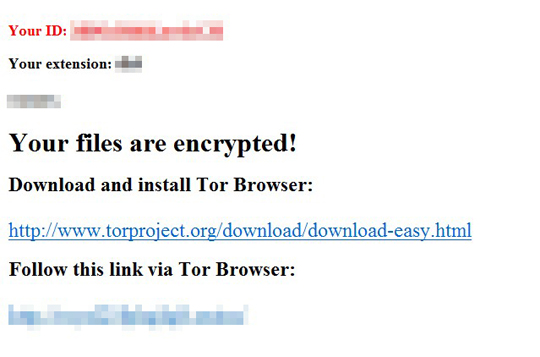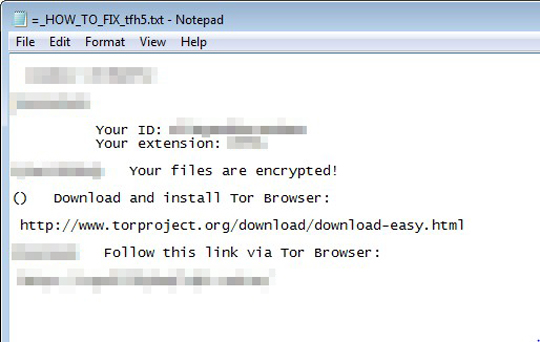RANSOM_CESLOCKER.THCOHAH
Trojan-Ransom.Win32.Agent.abuo (Kaspersky), Trojan:Win32/Occamy.B (Microsoft)
Windows


Threat Type: Ransomware
Destructiveness: No
Encrypted: Yes
In the wild: Yes
OVERVIEW
This Ransomware arrives as an attachment to email messages spammed by other malware/grayware or malicious users. It arrives on a system as a file dropped by other malware or as a file downloaded unknowingly by users when visiting malicious sites.
It connects to certain websites to send and receive information. It is capable of encrypting files in the affected system.
It encrypts files with specific file extensions. It drops files as ransom note.
TECHNICAL DETAILS
Arrival Details
This Ransomware arrives as an attachment to email messages spammed by other malware/grayware or malicious users.
It arrives on a system as a file dropped by other malware or as a file downloaded unknowingly by users when visiting malicious sites.
Installation
This Ransomware adds the following processes:
- %Program Files%\Internet Explorer\iexplore.exe" -nohome ← Command to set the Internet Explorer's home page disabled
(Note: %Program Files% is the default Program Files folder, usually C:\Program Files in Windows 2000, Server 2003, and XP (32-bit), Vista (32-bit), 7 (32-bit), and 8 (32-bit), or C:\Program Files (x86) in Windows XP (64-bit), Vista (64-bit), 7 (64-bit), and 8 (64-bit).)
It adds the following mutexes to ensure that only one of its copies runs at any one time:
- HhQVyWJgqt
Information Theft
This Ransomware gathers the following data:
- User Name
- System Processor
- System Locale ID
- OS Version
- System Language
Other Details
This Ransomware connects to the following website to send and receive information:
- {BLOCKED}.{BLOCKED}.125.1-176.10.125.254
- {BLOCKED}.{BLOCKED}.126.1-176.10.126.254
- {BLOCKED}.{BLOCKED}.127.1-176.10.127.254
It does the following:
- It skips to encrypt the following paths:
- $recycle.bin
- systemvolumeinformation
- temporaryinternetfiles
- programfiles
- programdata
- programfiles(x86)
- windows
- microsoft
- appdata
- localsettings
- recycler
- msocache
It is capable of encrypting files in the affected system.
Ransomware Routine
This Ransomware encrypts files with the following extensions:
- .1cd
- .3ds
- .3gp
- .accdb
- .ai
- .ape
- .asp
- .aspx
- .bc6
- .bc7
- .bmp
- .cdr
- .cer
- .cfg
- .cfgx
- .cpp
- .cr2
- .crt
- .crw
- .csr
- .csv
- .dbf
- .dbx
- .dcr
- .dfx
- .dib
- .djvu
- .doc
- .docm
- .docx
- .dwg
- .dwt
- .dxf
- .dxg
- .eps
- .htm
- .html
- .ibank
- .indd
- .jfif
- .jpe
- .jpeg
- .jpg
- .kdc
- .kwm
- .max
- .md
- .mdb
- .mdf
- .odb
- .odc
- .odm
- .odp
- .ods
- .odt
- .orf
- .p12
- .p7b
- .p7c
- .pef
- .pem
- .pfx
- .php
- .pl
- .png
- .pps
- .ppt
- .pptm
- .pptx
- .psd
- .pst
- .pub
- .pwm
- .py
- .qbb
- .qbw
- .raw
- .rtf
- .sln
- .sql
- .sqlite
- .svg
- .tif
- .tiff
- .txt
- .vcf
- .wallet
- .wpd
- .xls
- .xlsm
- .xlsx
- .xml
It appends the following extension to the file name of the encrypted files:
- .{Random Characters}
It drops the following file(s) as ransom note:
- {Encrypted Folder}\=_HOW_TO_FIX_{Random Characters}.html

- {Encrypted Folder}\=_HOW_TO_FIX_{Random Characters}.txt

- {Encrypted Fodler}\=_HOW_TO_FIX_{Random Characters}.url
SOLUTION
Step 1
Before doing any scans, Windows XP, Windows Vista, and Windows 7 users must disable System Restore to allow full scanning of their computers.
Step 2
Note that not all files, folders, and registry keys and entries are installed on your computer during this malware's/spyware's/grayware's execution. This may be due to incomplete installation or other operating system conditions. If you do not find the same files/folders/registry information, please proceed to the next step.
Step 3
Identify and terminate files detected as RANSOM_CESLOCKER.THCOHAH
- Windows Task Manager may not display all running processes. In this case, please use a third-party process viewer, preferably Process Explorer, to terminate the malware/grayware/spyware file. You may download the said tool here.
- If the detected file is displayed in either Windows Task Manager or Process Explorer but you cannot delete it, restart your computer in safe mode. To do this, refer to this link for the complete steps.
- If the detected file is not displayed in either Windows Task Manager or Process Explorer, continue doing the next steps.
Step 4
Search and delete these files
- {Encrypted Folder}\=_HOW_TO_FIX_{Random Characters}.html
- {Encrypted Folder}\=_HOW_TO_FIX_{Random Characters}.txt
- {Encrypted Fodler}\=_HOW_TO_FIX_{Random Characters}.url
Step 5
Scan your computer with your Trend Micro product to delete files detected as RANSOM_CESLOCKER.THCOHAH. If the detected files have already been cleaned, deleted, or quarantined by your Trend Micro product, no further step is required. You may opt to simply delete the quarantined files. Please check the following Trend Micro Support pages for more information:
Step 6
Restore encrypted files from backup.
Did this description help? Tell us how we did.



